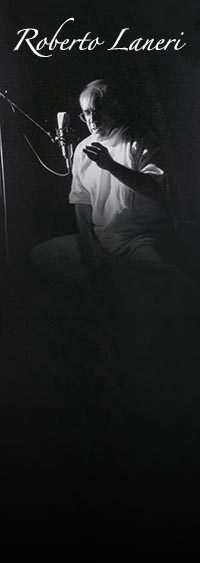Roberto Laneri
Compositor
BLUESPRINTS-MUSICA FINTA
a work available in various forms: as a recital for soprano sax and piano, with or without prerecorded electronic parts; as a multimedia show with images by Alberto Tessore, recorded voice by Ottavia Fusco or Alana Ferry (Italian or English version), texts by Roberto Laneri, taken from “Hear Me Talkin’ To Ya” (Nat Shapiro and Nat Hentoff, and Julio Cortàzar (from “The Pursuer”).
MUSICA FINTA/MUSICA FICTA:The first musical compositions in the West, from 1100 a.d. until almost 1600, were built on a pre-existing and well-known basis (cantus firmus). Musicians had the option of inserting changes in the open spaces of scores which were sometimes barely traced. In such cases the text might take different outcomes, according to the rules of musica ficta or musica falsa (“causa pulchritudinis vel necessitatis”) as laid out for example in the treatise Introductio Musicae by John of Garland. An extreme interpretation of musica falsa is represented by Lowinsky’s theory of “secret modulation,” according to which some pieces were conceived so as to support both an essoteric and an esoteric reading. Therefore, following the musica ficta indications, it was possible through a sequence of forced turns to derive a version of the text whose melodic and harmonic sense was sometimes radically divergent from the original. One of the best-and best known-examples of this “secret chromaticism” is the motet Vox in Rama by the Flemish composer Clemens non Papa (ca. 1510 ca. 1556). Playing some rags by Scott Joplin on soprano sax I started to introduce some changes in the text, minimal ones at first, then more substantial, until I ended up composing autonomous and parallel pieces, to be performed together with the original ones. The end result of such operation is somewhat akin to Escher’s impossible perspectives, or today’s computer-generated 3-dimensional drawings, where images may emerge which are complementary yet very different from those which immediately appear. This kind of “variation with a theme” has extended to other musics, by Schubert, Schumann, Jelly Roll Morton, in a very personal revisitation of the events leading to the birth of jazz. Throughout MUSICA FINTA, sometimes openly, some other times more subtly in the sound and phrasing of the soprano sax, homage is paid to the first musicians I have loved: mostly Sidney Bechet, Jelly Roll Morton, Louis Armstrong, and quite a few others.
This show recreates in sounds and images the atmosphere, between the end of ‘800 and the beginning of ‘900, in which Afroamerican music originated: the voices of nature and the spirits of Africa, the first blues, European music (Schubert, Schumann), the first great soloists (Jelly Roll Morton, Louis Armstrong, James P. Johnson, Sidney Bechet). Concerning the music, the electronic parts (the blues prints) consist of samplings of musics from the times re-elaborated and manipulated. The hiss of the original recordings has been kept, much like the grain and imperfections in old photos. The live parts (the musica finta) consist of musics written on other musics (by Schumann, Schubert, Scott Joplin, Jelly Roll Morton), to be performed together with the original piano pieces. Alberto Tessore’s multivision images run parallel to the sound episodes:
1.PROLOGUE: after a live introduction based on the first piece of the Kinderszenen by Schumann (“Of far away men and lands”), this episode evokes the distant African origins, born in the shady misteries of the forest and traveling to America aboard the slave merchant ships.
2.ALL THESE RAINY DAY: the plantations around the Mississippi Delta, where the work songs of the black slaves were born.
3.LADIES SING THE BLUES: the urban slums of New Orleans, where the first blues singers from the nearby country moved to.
4.JELLY ROLL, THE SPANISH TINGE: the splendid whorehouses of the red light district, places of luxury and culture, where one could hear pianists of Jelly Roll Morton’s caliber.
5.LIVE MUSIC 1: the musica finta overlaps with The Crave (a Jelly Roll Morton Spanish-style piece), a Schubert waltz, Solace (the only tango by Scott Joplin, bearing the undertitle of Mexican Serenade), and the well-known Entertainer.
6.LOUIS THE GREAT: a homage to the great Louis Armstrong, in which the triumph of the trumpet and the brass instruments come to life again in bursts of yellows.
7.LIVE MUSIC 2: in this second installment the musica finta itself conforms to the Armstrong style, taking as a point of departure livelier pieces, such as Mister Joe by Morton, Magnetic Rag by Joplin, another waltz by Schubert and Joplin’s Original Rags.
8.THE TENDERLOIN DISTRICT: losing oneself in a brothel where the high priestesses of pleasure appear under their stage names, as the whirling flow of James P. Johnson’s notes unsettle the mind and the senses.
9.SIDNEY “LE DIEU”: coming out of the pleasure-house, following the flow of improvisation and flying in an artificial sky in the company of Bechet “le Dieu”, who capers among clouds, instruments and dream-women.
TECHNICAL REQUIREMENTS
BLUESPRINTS in concert-form: grand piano, tuned before the performance, 3 music stands, P.A. system necessary in a hall of great dimensions (to be specified).
BLUESPRINTS as a multimedia show: as before, plus 5 music stands with lights, P.A. system 12-channel mixer, 2 monitors, 5 microphones, CD reader, videoprojector. Projection requirements vary according to the space (projection screen, white wall, etc.). Total darkness is a necessity.
Roberto Laneri
©2018-2025
